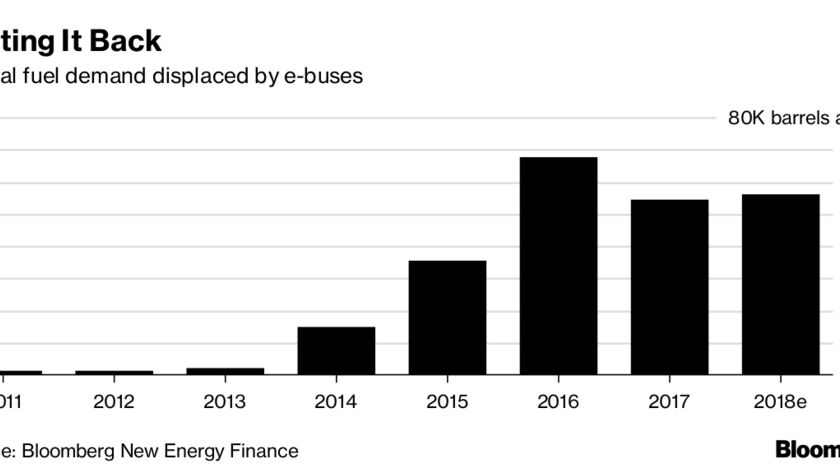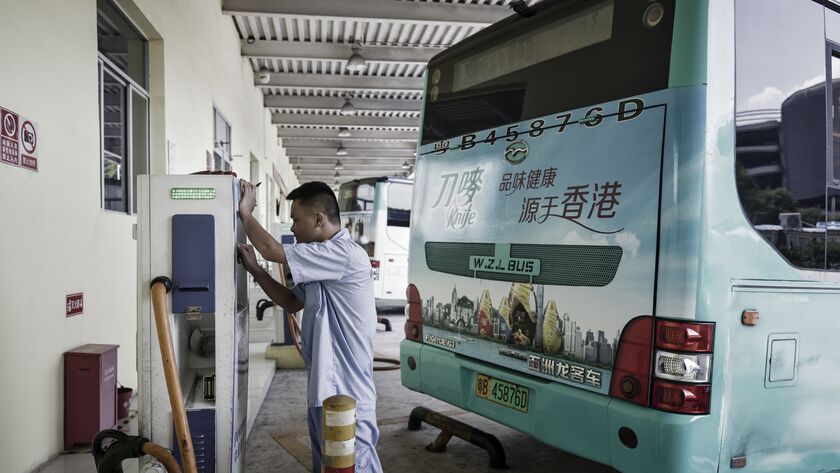Electric buses were seen as a joke at an industry conference in Belgium seven years ago when the Chinese manufacturer BYD Co. showed an early model.
“Everyone was laughing at BYD for making a toy,” recalled Isbrand Ho, the Shenzhen-based company’s managing director in Europe. “And look now. Everyone has one.”
Suddenly, buses with battery-powered motors are a serious matter with the potential to revolutionize city transport—and add to the forces reshaping the energy industry. With China leading the way, making the traditional smog-belching diesel behemoth run on electricity is starting to eat away at fossil fuel demand.
The numbers are staggering. China had about 99 percent of the 385,000 electric buses on the roads worldwide in 2017, accounting for 17 percent of the country’s entire fleet. Every five weeks, Chinese cities add 9,500 of the zero-emissions transporters—the equivalent of London’s entire working fleet, according Bloomberg New Energy Finance.
All this is starting to make an observable reduction in fuel demand. And because they consume 30 times more fuel than average sized cars, their impact on energy use so far has become much greater than the passenger sedans produced by companies from Tesla Inc. to Toyota Motor Corp.

For every 1,000 battery-powered buses on the road, about 500 barrels a day of diesel fuel will be displaced from the market, according to BNEF calculations. This year, the volume of fuel not needed may rise 37 percent to 279,000 barrels a day because of electric transport including cars and light trucks, about as much oil as Greece consumes, according to BNEF. Buses account for about 233,000 barrels of that total.
“This segment is approaching the tipping point,” said Colin McKerracher, head of advanced transport at the London-based research unit of Bloomberg LP. “City governments all over the world are being taken to task over poor urban air quality. This pressure isn’t going away, and electric bus sales are positioned to benefit.”
China is ahead on electrifying its fleet because it has the world’s worst pollution problem. With a growing urban population and galloping energy demand, the nation’s legendary smogs were responsible for 1.6 million extra deaths in 2015, according to non-profit Berkeley Earth.

A decade ago, Shenzhen was a typical example of a booming Chinese city that had given little thought to the environment. Its smog became so notorious that the government picked it for a pilot program for energy conservation and zero emissions vehicles in 2009. Two years later, the first electric buses rolled off BYD’s production line there. And in December, all of Shenzhen’s 16,359 buses were electric.
BYD had 13 percent of China’s electric bus market in 2016 and put 14,000 of the vehicles on the streets of Shenzhen alone. It’s built 35,000 so far and has capacity to build as many as 15,000 a year, Ho said.

BYD estimates its buses have logged 17 billion kilometers (10 billion miles) and saved 6.8 billion liters (1.8 billion gallons) of fuel since they started ferrying passengers around the world’s busiest cities. That, according to Ho, adds up to 18 million tons of carbon dioxide pollution avoided, which is about as much as 3.8 million cars produce in each year.
“The first fleet of pure electric buses provided by BYD started operation in Shenzhen in 2011,” Ho said by phone. “Now, almost 10 years later, in other cities the air quality has worsened while—compared with those cities—Shenzhen’s is much better.”

Other cities are taking notice. Paris, London, Mexico City and Los Angeles are among 13 authorities that have committed to only buying zero emissions transport by 2025.
London is slowly transforming its fleet. Currently four routes in the city center serviced by single-decker units are being shifted to electricity. There are plans to make significant investments to the clean its public transport networks, including retrofitting 5,000 old diesel buses in a program to ensure all buses are emission-free by 2037.

Transport for London, responsible for the city’s transport system, declined to comment for this article because of rules around engaging with the media ahead of May local government elections.
Those goals will have an impact on fuel consumption. London’s network draws about 1.5 million barrels a year of fuel. If the entire fleet goes electric, that may displace 430 barrels a day of diesel for each 1,000 buses going electric, reducing U.K. diesel consumption by about 0.7 percent, according to BNEF.

Across the U.K. there were 344 electric and plug-in hybrid buses in 2017, and BYD hopes to be picked to supply more. It has partnered with a Scottish bus-maker to provide the batteries for 11 new electric buses that hit the city’s roads in March.
Falkirk-based manufacturer Alexander Dennis Ltd. began making electric buses in 2016 and has quickly become the European market leader with more than 170 vehicles operating in the U.K. alone.
More work is on the horizon, with London’s transport authority planning a tender to electrify its iconic double-decker buses, Ho said.
“The tech is ready,” Ho said. “We are ready, we have our plants in China, and Alexander Dennis in Scotland is geared up for TfL. Once we’re given the word, we are ready to go.”
No comments:
Post a Comment
Note: Only a member of this blog may post a comment.